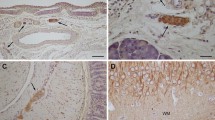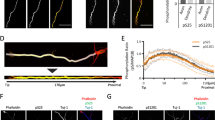Abstract
The appearance of the glial fibrillary acidic protein (GFAP) during embryonic and postnatal development of the rat brain and spinal cord and in rat sciatic nerve during postnatal development was examined by the immunoblot technique. Cytoskeletal proteins were isolated from the central and peripheral nervous system and separated by SDS slab gel electrophoresis or two-dimensional gel electrophoresis. Proteins from the acrylamide gels were transferred to nitrocellulose sheets which were treated with anti-bovine GFAP serum and GFAP was identified by the immunoblot technique. GFAP was present in the embryonic rat brain and spinal cord at 14 and 16 days of gestation respectively. The appearance of GFAP at this stage of neural development suggests that the synthesis of GFAP may be related to the proliferation of radial glial cells from which astrocytes are derived. It is also feasible that GFAP provides structural support for the radial glial cell processes analogous to its role in differentiated astrocytes. GFAP was found to be present in rat sciatic nerves at birth and at all subsequent stages of development. These results indicate that some cellular elements in the rat sciatic nerve, such as Schwann cells, are capable of synthesizing GFAP which is immunochemically indistinguishable from its counterpart in the central nervous system. Thus it appears that GFAP is present both in the central and peripheral nervous system of the rat when the glial cells synthesizing GFAP are still undergoing differentiation.
Similar content being viewed by others
References
Eng, L. F., Vanderhaeghen, J. J., Bignami, A., andGerstl, B. 1971. An acidic protein isolated from fibrous astrocytes. Brain Res. 28:351–354.
Dahl, D., andBignami, A. 1973. Glial fibrillary acidic protein from normal human brain. Purifications and properties. Brain Res. 57:343–360.
Chiu, F.-C., Korey, B. andNorton, W. T. 1980. Intermediate filaments from bovine, rat, and human CNS: Mapping analysis of the major proteins. J. Neurochem. 34:1149–1159.
Eng, L. F. 1980. The glial fibrillary acidic (GFA) protein. Pages 85–117,in R. A. Bradshaw andD. M. Schneider, (eds.), Proteins of the Nervous System, Raven Press, New York.
Noetzel, M. J., Roots, B. I., andAgrawal, H. C. 1983. Appearance of the glial fibrillary acidic protein and phosphorylation of the neurofilament proteins in the developing rat nervous system. Society for Neuroscience Abstracts 9:235.
Chiu, F.-C., Norton, W. T., andFields, K. L. 1981. The cytoskeleton of primary astrocytes in culture contains actin, glial fibrillary acidic protein, and the fibroblast-type filament protein, vimentin. J. Neurochem. 37:147–155.
Lowry, O. H., Rosebrough, N. J., Farr, A. L., andRandall, R. J. 1951. Protein measurement with the Folin phenol reagent. J. Biol. Chem. 193:265–275.
Fishman, M. A., Hagen, S., Trotter, J. L., O'Connell, K. andAgrawal, H. C. 1979. Use of a stable fluorescent reagent, 2-methoxy-2, 4-diphenyl-3(2H)-furanone, for the visualization and purification of myelin proteins. J. Neurochem. 32:1077–1083.
Laemmli, U. K. 1970. Cleavage of structural protein during the assembly of the head of bacteriophage T4. Nature (Lond.) 227:680–685.
Dubray, G., andBezard, G. 1982. A highly sensitive periodic acid-silver stain for 1,2-diol groups of glycoproteins and polysaccharides in polyacrylamide gels. Anal. Biochem. 119:325–329.
Thomas, K. A., Silverman, R. E., Jeng, I., Baglan, N. C., andBradshaw, R. A. 1981. Electrophoretic heterogeneity and polypeptide chain structure of the γ-subunit of mouse submaxillary 7S nerve growth factor. J. Biol. Chem. 256:9147–9155.
Towbin, H., Staehelin, T., andGordon, J. 1979. Electrophoretic transfer of proteins from polyacrylamide gels to nitrocellulose sheets: Procedure and some applications. Proc. Natl. Acad. Sci. USA. 76:4350–4354.
Gilbert, W. R., Garwood, M. M., Egrawal, D., Schmidt, R. E., andAgrawal, H. C. 1982. Immunoblot identification of phosphorylated basic proteins of rat and rabbit CNS and PNS myelin: Evidence for four phosphorlyated basic proteins and P2 in rat PNS myelin. Neurochem. Res. 7:1495–1506.
O'Farrell, P. H. 1975. High resolution two-dimensional electrophoresis of proteins. J. Biol. Chem. 250:4007–4021.
Dahl, D., Strocchi, P., andBignami, A. 1982. Vimentin in the central nervous system. Differentiation. 22:185–190.
Chan, P. H., Huston, J. S., Moo-Penn, W. F., Dahl, D., andBignami, A. 1977. Biochemical studies related to CNS regeneration: Isolation and partial characterization of urea-soluble gliofibrillary acidic protein from bovine brain. Pages 496–524,in Proceedings of the Second Annual Maine Biomedical Science Symposium, Vol. 2, University of Maine Press, Orono.
Schlaeffer, W. W., andZimmerman, U.-J.P. 1981. Calcium-mediated breakdown of glial filaments and neurofilaments in rat optic nerve and spinal cord. Neurochem. Res. 6:243–255.
DeArmond, S. J., Fajardo, M., Naughton, S. A., andEng, L. F. 1983. Degradation of glial fibrillary acidic protein by a calcium dependent proteinase: An electroblot study. Brain Res. 262:275–282.
Bignami, A. andDahl, D. 1974. Astrocyte-specific protein and neuroglial differentiation. An immunofluorescence study with antibodies to the glial fibrillary acidic protein. J. Comp. Neuro. 153:27–38.
Raju, T., Bignami, A., andDahl, D. 1981. In vivo and in vitro differentiation of neurons and astrocytes in the rat embryo. Dev. Biol. 85:344–357.
Abney, E. R., Bartlett, P. P., andRaff, M. C. 1981. Astrocytes, ependymal cells, and oligodendrocytes develop on schedule in dissociated cell cultures of embryonic rat brain. Dev. Biol. 83:301–310.
Choi, B. H. 1981. Radial glia of developing human fetal spinal cord: Golgi, immunohistochemical and electron microscopic study. Develop. Brain Res. 1:249–267.
Schmechel, D. E., andRakic, P. 1979. A Golgi study of radial glial cells in developing monkey telencephalon: Morphogenesis and transformation into astrocytes. Anat. Embryol. 156:115–152.
Bignami, A., andDahl, D. 1973. Differentiation of astrocytes in the cerebellar cortex and the pyramidal tracts of the newborn rat. An immunofluorescence study with antibodies to a protein specific to astrocytes. Brain Res. 49:393–402.
Hartman, B. K., Agrawal, H. C., Agrawal, D., andKalmbach, S. 1982. Development and maturation of central nervous system myelin: Comparison of immunohistochemical localization of proteolipid protein and basic protein in myelin and oligodendrocytes. Proc. Nat. Acad. Sci. USA. 79:4217–4220.
Berry, M., andRogers, A. W. 1965. The migration of neuroblasts in the developing cerebral cortex. J. Anat. 99:691–709.
Del Cerro, M. P., andSnyder, R. S. 1971. Studies on the developing cerebellum. II. The ultrastructure of the external granular layer. J. Comp. Neur. 144:131–164.
Rakic, P. 1972. Mode of cell migration to the superficial layers of fetal monkey neocortex. J. Comp. Neuro. 145:61–84.
Rakic, P. 1981. Neuronal-glial interaction during brain development. Trends in Neuroscience. 4, 184–187.
Stewart, R. M., andRosenberg, R. N. 1979. Physiology of glia: Glial-neuronal interactions. International Rev. Neurobiol. 21:275–309.
Choi, B. H., andLapham, L. W. 1978. Radial glia in the human fetal cerebrum: A combination golgi, immunofluorescent and electron microscopic study. Brain Res. 148:295–311.
Elfvin, L. G. 1961. Electron-microscopic investigation of filament structures in unmyelinated fibres of cat splenic nerve. J. Ultrastruct. Res. 5:51–64.
Blümcke, S., andNiedorf, H. R. 1966. Electron microscope studies of Schwann cells during the Wallerian degeneration with special reference to the cytoplasmic filaments. Acta Neuropath. 6:46–60.
Bignami, A., andDahl, D. 1977. Specificity of the glial fibrillary acidic protein for astroglia. J. Histochem. Cytochem. 25:466–469.
Jessen, K. R., andMirsky, R. 1980. Glial cells in the enteric nervous system contain glial fibrillary acidic protein. Nature. 286:736–737.
Yen, S-H., andFields, K. L. 1981. Antibodies to neurofilament, glial filament, and fibroblast intermediate filament proteins bind to different cell types of the nervous system. J. Cell Biol. 88:115–126.
Eng, L. F., andDeArmond, S. J. 1983. Immunochemistry of the glial fibrillary acidic protein. Pages 19–39,in H. M. Zimmermann, (ed.), Progress in Neuropathology, Vol. 5. Raven Press, New York. 19–39.
Dahl, D., Chi, N. H., Miles, L. E., Nguyen, B. T., andBignami, A. 1982. Glial fibrillary acidic (GFA) protein in Schwann cells: Fact or artifact? J. Histochem. Cytochem. 30:912–918.
Fields, K. L. 1983. Differentiated Schwann cells cultured from adult sciatic nerves contain astrocyte type intermediate filaments. Society for Neuroscience Abstracts. 9:5.
Jessen, K. R., Thorpe, R., andMirsky, R. 1984. Molecular identity, distribution and heterogeneity of glial fibrillary acidic protein: an immunoblotting and immunohistochemical study of Schwann cells, satellite cells, enteric glia and astrocytes. Jour. Neurocytol. 13:187–200.
Yen, S-H., andFields, K. L. 1983. Schwann cells contain a protein similar to the CNS astroglial filament protein. Society for Neuroscience Abstracts. 9:235.
Webster, H. deF., Martin, J. R., andO'Connell, M. F. 1973. The relationship between interphase Schwann cells and axons before myelination: A quantitative electron microscopic study. Dev. Biol. 32:401–416.
Trapp, B. D., Itoyama, Y., Sternberger, N. H., Quarles, R. H., andWebster, H. deF. 1981. Immunocytochemical localization of Po protein in golgi complex membranes and myelin of developing rat Schwann cells. J. Cell Biol. 90:1–6.
Author information
Authors and Affiliations
Rights and permissions
About this article
Cite this article
Noetzel, M.J., Agrawal, H.C. Immunoblot identification of glial fibrillary acidic protein in rat sciatic nerve, brain, and spinal cord during development. Neurochem Res 10, 737–753 (1985). https://doi.org/10.1007/BF00964532
Accepted:
Issue Date:
DOI: https://doi.org/10.1007/BF00964532




